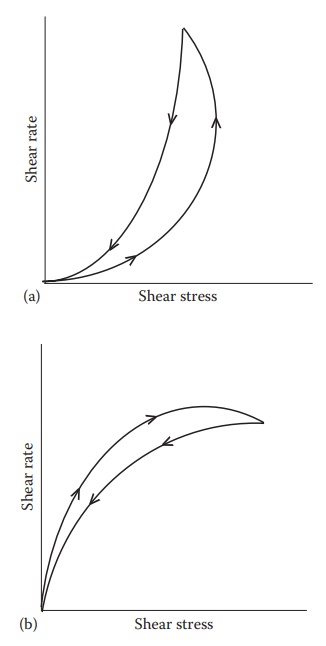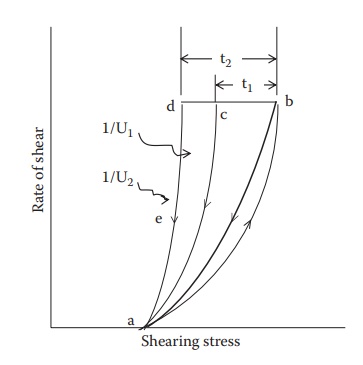Thixotropy
| Home | | Pharmaceutical Drugs and Dosage | | Pharmaceutical Industrial Management |Chapter: Pharmaceutical Drugs and Dosage: Rheology
Thixotropy is the property of some non-Newtonian fluids to show a time-dependent change in viscosity.
Thixotropy
Thixotropy
is the property of some non-Newtonian fluids to show a time-dependent change in
viscosity. For dilatant (shear-thickening) thixotropic fluids, the longer the
fluid undergoes shear, the more its viscosity. For pseudoplastic
(shear-thinning) thixotropic fluids, the longer the fluid undergoes shear, the
lower its viscosity.
Many
gels and colloids are pseudoplastic thixotropic materials, exhibiting a stable
form at rest but becoming fluid when agitated with a reversible gel–sol
transformation phenomenon. When sheared by mixing, such as simple shaking, the
matrix relaxes and forms a solution with the charac-teristics of a liquid
dosage form for ease of use. Although pseudoplastic fluids show thinning with
only increasing rate of shear, thixotropic fluids show increasing flow and
thinning as the duration of mixing increases, even at the same shearing forces.
On setting, the higher-viscosity plastic state resumes as a network gel forms
and provides a rigid matrix that stabilizes suspensions and gels.
The
molecular basis of thixotropic behavior of fluids lies in changes in
intermolecular interactions of solute on persistence of shear. Thus,
pseudo-plastic thixotropic systems show thinning behavior not only with
increasing shear but also with increasing duration of shear, owing to changes
in the alignment of solute molecules that reduce their intermolecular
interactions. Conversely, dilatant thixotropic systems show thickening behavior
not only with increasing shear but also with increasing duration of shear,
owing to swelling and/or intermolecular entanglement or interparticle
interactions, which cause increased interparticle bonding or intermolecular
attractive interactions with time.
The
term thixotropic fluid is sometimes used to refer to pseudoplastic
(shear-thinning) thixotropic behavior. Conversely, the term negative
thix-otropy or antithixotropy is sometimes used to refer to a dilatant
(shear-thickening) thixotropic behavior, that is, a time-dependent increase
rather than a decrease in apparent viscosity on application of a shearing
stress.
The
main advantage of pseudoplastic thixotropic preparations is that the particles
remain in suspension during storage, but when required for use, the pastes are
readily made fluid by tapping or shaking. This is true for both pseudoplastic
and thixotropic fluids. For thixotropic fluids, the duration of shearing or
shaking, even at the same shear stress, also impacts shear thin-ning to the
fluid. For example, concentrated parenteral suspensions con-taining from 40% to
70% w/v of procaine penicillin G in water show high inherent pseudoplastic
thixotropic behavior.
Hysteresis loop
Hysteresis
loop represents different path of response (shear rate) to the experimental
parameter (shear stress) when the experimental parameter is increased or
decreased. Thixotropic systems show an up–down curve, called hysteresis loop,
such that for a given shear stress, the flow response is a function of the
history of the sample—increasing the shear stress (up curve) leads to different
flow behavior than if the shear stress were decreas-ing (down curve). Typical
rheograms for pseudoplastic and dilatant systems exhibiting this behavior are
shown in Figure 12.2.

Figure 12.2 Thixotropy in pseudoplastic and
dilatant flow systems: (a) thixotropy in pseudoplastic material and (b)
thixotropy in dilatant material.
Rheograms
of pseudoplastic thixotropic materials are highly dependent on the rate at
which shear is increased or decreased and the length of time for which a sample
is subjected to any one rate of shear or shear stress. As shown in Figure 12.3 for a pseudoplastic thixotropic system
shown in Figure 12.2a, the shear rate (or flow)
increases from point “a” to point “b” with an increase in shear stress and
decreases from “b” to “e” with a decrease in the shear stress. This forms the
hysteresis loop “abe.” However, if the sample was taken to point “b” and the
shear rate was held constant for a certain period of time (say, t1 seconds), the rate of
shear (and hence the consistency and

Figure 12.3 Relationship between shearing stress and rate of shear for a plastic system possessing thixotropy.
Consequently, to maintain the same
desired rate of shear (as in point “b”), the amount of shear stress required is
progressively lower as time passes (t2
> t1)—represented by
the horizontal line from “b” to “c” for t1 and “b” to “d” for t2
in Figure 12.3. This decrease in the required
shear stress to maintain the same rate of shear is attributed to reduction in
the degree or amount of structure in the sample.
Decreasing
the rate of shear to zero after having reached the state “b,” “c,” or “d”
(depending on the time for which shear stress is applied at con-stant shear
rate) would create hysteresis loops aba, aca, or ada, respectively. Therefore,
in contrast to pseudoplastic or dilatant materials, the rheogram of a
thixotropic material is not unique but depends on the rheologic history of the
sample and the approach used to obtain the rheogram. For example, keeping the
constant shear stress at point “b” for times t1 and t 2
would result in very different rheograms than the rheogram shown in Figure 12.3, where the shear rate was kept constant
at point “b.” Student exercise: draw the rheograms for the case where shear
stress is kept constant for times t1
and t2 at point “b” and
compare them with that in Figure 12.3. This
property of thixotropic systems is important to bear in mind when attempting to
obtain a quantitative measure of viscosity and flow of thixotropic systems.
Related Topics
